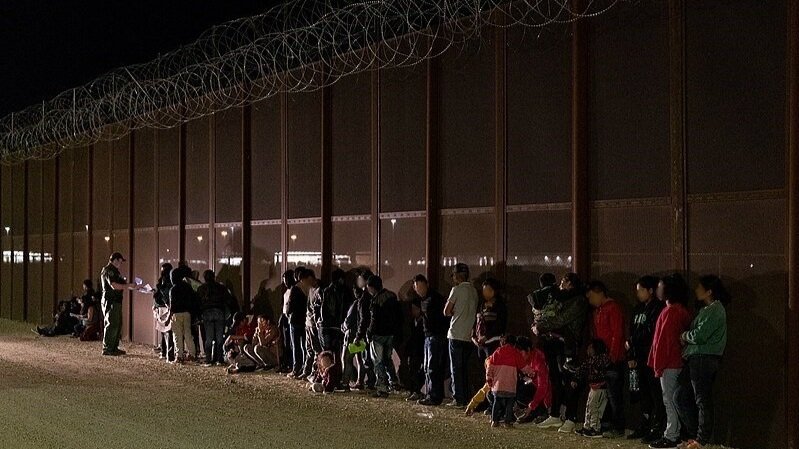In new book, Jonathan Blitzer explains tangled web of U.S. politics and policy that helped create the border crisis
As a social worker back in the 1960s, I provided services to migrant farmworkers in Iowa, many of whom were illegal aliens. By then, a potent mix of racism, fear and misinformation already shaped U.S. immigration policy at the southern border.
More than 40 years ago, Ronald Reagan’s Select Committee on Immigration and Refugee Policy, chaired by University of Notre Dame President Theodore Hesburgh, suggested that problems at the southern border (exemplified above by the public domain photo of the Yuma, AZ, border crossing posted in wikimedia commons) required closing the back door to undocumented and illegal immigrants and, at the same time, opening the front door to facilitate legal asylum and immigration.
No one asked, then or now, why are so many people immigrating? Why has the demographic shifted from single Mexican men seeking work to unaccompanied children from the northern triangle of Central America (El Salvador, Guatemala and Honduras) requesting asylum? Why are applications for legal entry at the southern border turned down at a much higher rate than immigrants from Europe, Asia and Africa at other ports of entry?
One day last month, I listened with interest to an NPR “Fresh Air” interview by Terry Gross with journalist Jonathan Blitzer about his recently released book, “Everyone Who Is Gone Is Here: The United States, Central America, and the Making of a Crisis.”
In 43 minutes, Blitzer summarized 55 years of American politics that have inexorably marched us to this war at the southern border.
I immediately purchased the Kindle version of Blitzer’s book. I conscientiously plowed through all 464 pages of exhaustively described policy changes as the presidential pendulum swung from left to right, then from less left to further right. Most notably, Blitzer criticized Democrats and Republicans with equal zeal.
He drew on the past five years of articles he wrote for The New Yorker and seven years of interviews he conducted. He clearly had read the actual laws and executive orders affecting immigration. His list of secondary sources indicated an extensive knowledge of other authors’ work.
His reconstruction of 55 years of political players and government policies verged on being too detailed to follow. But then, immigration has never been a simple issue with straight-forward solutions. Blitzer connected his narrative to the professional trajectories of four people in an attempt, I think, to help the reader comprehend a very complicated history.
He introduced John Fife, a Presbyterian minister and advocate in Tucson who founded a national network of churches willing to offer sanctuary. Fife often faced off with Doris Meissner, who rose through the ranks of the Justice Department, then moved to the Immigration and Naturalization Service in the Clinton administration.
Blitzer interviewed Scott Mechkowski, an INS field agent who reveled in the redefinition of “criminal” under George W. Bush’s transformation of INS to ICE. The newly-created Department of Homeland Security with its sweeping powers of investigation and arrest no longer limited its target to violent criminals; the new definition included people with traffic tickets, DUIs and shoplifting charges.
Deportations skyrocketed.
In contrast, Cecilia Muñoz, an advocate for humane approaches, worked with the National Council of La Raza and advocated for a family unity policy. She eventually became an immigration advisor to President Barack Obama and witnessed his early humanitarian stance shift to a pragmatic approach that earned him the nickname of “Deporter in Chief.”
I appreciated Blitzer’s strategy. It helped me see how these four, and probably many more people involved in immigration questions, were committed and passionate even though they periodically struggled with opposing choices of “do the right thing” versus “do the expedient thing” and, in either case, saw their best efforts fail more often than succeed even in modest measure.
Immigration, however, is not just about policies and numbers of immigrants waiting at the border.
Blitzer shares his personal connection to four people whose lives were devastated by immigration policies. Their stories brought me to tears.
Juan Romagoza, a cardiac surgeon in El Salvador tortured by the CIA-supported military, escaped to the United States. Keldy Mabel Gonzáles Brebe de Zuniga survived 1998’s Hurricane Mitch in Honduras although 11,000 other people did not. Lucrecia Hernández Mack returned to Guatemala and bravely challenged the corrupt judicial system to bring her mother’s murderers to justice. Eddie Anzora came to Los Angeles at the age of 3 with his family but was eventually deported to El Salvador.
All four faced violence, extreme poverty and post-traumatic stress. All four lost family members to political violence. All four had to navigate constant interruptions in their lives as they moved between their home countries, the United States and back home again.
Blitzer wove together experiences of professionals and immigrants against the background of his main thesis. He firmly linked today’s crisis to Reagan who bolstered Latin American dictators in his attempt to prevent the spread of what he saw as communism. For Reagan, trade union organizers and farmers trying to wrest their small holdings back from giant corporations such as the United Fruit Company were examples of communists thwarting business.
Violence under Reagan-supported dictators in the northern triangle led to a rise in both legal and illegal immigration. In a cascade of consequences, two gangs in East LA, MS-13 and 18th Street, filled their ranks with Latino immigrants stuck in poverty. Those gangs spread through deportation and now constitute powerful, international organizations that control governments in many Latin American countries and throughout the world, creating the violence and poverty that leads to even greater impetus for their citizens to attempt immigration to the U.S.
In answer to my questions posed at the outset, immigration is increasing because of the increase in starvation exacerbated by climate change and its attendant hurricanes, floods and crop failures.
“Economic immigrants,” i.e. those wanting to work in order to send money home, have given way to greater numbers of “political immigrants,” i.e., those fleeing increased violence in their countries of origin due mostly to MS-13 and 18th Street gangs. Too many American politicians accept the myth that people with leftist views are automatically communists and thus favor immigration policies that prevent and reject people from South America in much greater numbers than people from other continents.
In great frustration, I finished reading Blitzer’s book knowing that this is not, as some Republicans say, Biden’s Border Crisis. It is clearly Reagan’s Crisis Creation. His immigration policy and border management, still in use today, appeared to be just as successful as his trickle-down theory and just as mindlessly swallowed by MAGA Trumpers.
Still, does knowing the origin and exponential growth of the crisis help policy-makers now? We cannot turn the clock back, but we should, in my opinion, look beyond short-term solutions. Even the current bipartisan bill limits policies to the old standby of front and back door changes: increase pathways to citizenship and issue more work permits on the one hand and decrease the number of applicants through deterrence and lower quotas on the other hand.
We apparently have not learned that deterrence of immigration is less effective than strategies of deterrence in our penal institutions where long prison terms fail to deter further offenses. Even the harshest and most inhumane immigration deterrent, family separation, failed to dissuade people from fleeing starvation and extreme violence in their home countries.
Blitzer, as a journalist, chose only to chronicle the crisis not to make recommendations on addressing it.
I have no such restriction.
Donald Trump’s rejection of the bipartisan bill now in Congress is, on the surface, motivated by his need for a campaign issue. A deeper dive, in my opinion, exposes his desire to stop immigration altogether, following the lead of his longtime advisor, Stephen Miller. Neither Trump nor Miller, nor their wealthy counterparts, want to share the dwindling resources of a planet beset by climate change.
Short-term policies can never address the need for long-term solutions. We need to invest in research to find seeds and crops that can provide food in changed environmental conditions, at home as well as abroad. We need to invest in small entrepreneurship to grow the economies of struggling countries and thereby combat the violence of gang-controlled governments. In other words, we need to address starvation, poverty and violence, the roots of immigration, rather than just people’s desperate actions to survive and provide futures for their children.
Most of all, however, I recommend that “Everyone Who is Gone is Here” should be required reading for Rep. Dusty Johnson.
Lilah Morton Pengra has authored several books (“Your Values, My Values,” “Sarah Campell,” “Isaiah Dorman,” and “A Hermosa Mystery”) and written articles for American Anthropologist, True West, Greasy Grass, West River History Conference, Hermosa Newsletter and Little Bighorn Research Review. Pengra earned a Bachelor of Arts at Grinnell College in Iowa, a master’s in anthropology and African studies, a PhD in anthropology from the University of Wisconsin-Madison, and a post-doctorate in medical anthropology. She lives near Buffalo Gap, SD, and can be contacted at lilah@hcinet.net.







